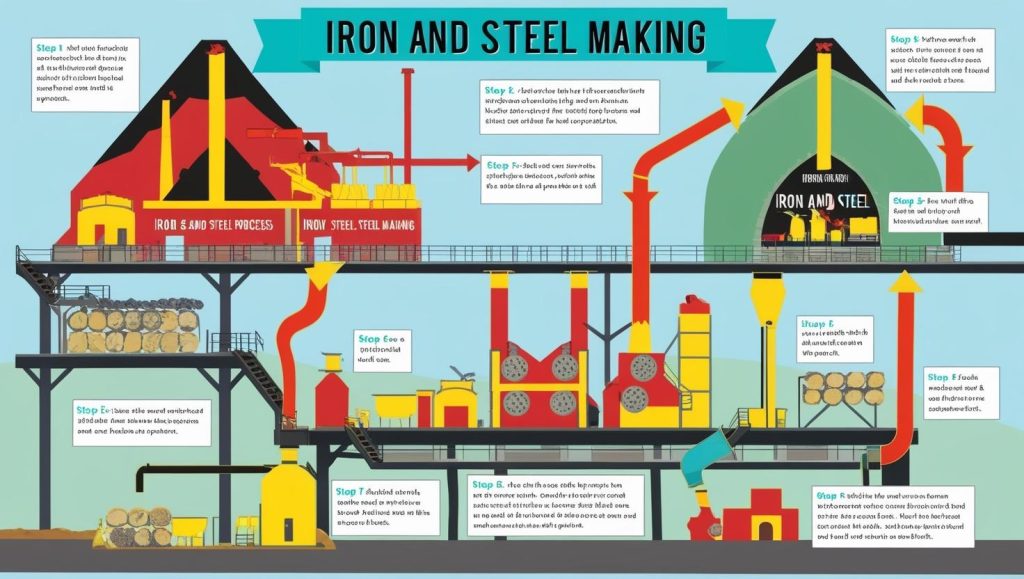Introduction to Iron Making and Steel Making Homework Help
Iron and steel are the backbone of modern civilization, forming the foundation of industries such as construction, automotive, shipbuilding, and manufacturing. Understanding the processes of iron making and steel making is crucial for students studying metallurgy, material science, and mechanical engineering. However, mastering these subjects can be challenging, which is why Iron Making and Steel Making homework help is essential for academic success.

This detailed guide will cover:
- The importance of iron and steel in modern industries
- The processes involved in iron making and steel making
- Key concepts, raw materials, and technologies used
- Challenges faced by students in these subjects
- Useful resources and expert tips for excelling in assignments
By the end of this guide, you will have a clear understanding of how to approach assignments related to iron making and steel making.
Understanding Iron Making and Steel Making
1. What is Iron Making?
Iron making is the process of extracting iron from its ores and refining it for use in steel production. The primary method for iron making is the blast furnace process, which involves reducing iron ore using carbon-based materials like coke.
Steps in Iron Making:
- Ore Preparation: Iron ore (hematite or magnetite) is crushed, washed, and pelletized.
- Charging the Blast Furnace: Iron ore, coke, and limestone are fed into the blast furnace.
- Reduction Process: The coke reacts with oxygen to produce carbon monoxide, which reduces iron ore to molten iron.
- Molten Iron Collection: The molten iron is extracted and sent for further refinement.
For more details on the blast furnace process, visit World Steel Association.
2. What is Steel Making?
Steel making is the process of refining iron to produce high-quality steel. There are two main methods of steel making:
- Basic Oxygen Furnace (BOF) Process – Used for mass production of steel from molten iron.
- Electric Arc Furnace (EAF) Process – Used for recycling scrap steel and producing specialty steels.
Steps in Steel Making:
- Primary Refining: Removal of impurities such as sulfur and phosphorus from molten iron.
- Secondary Refining: Adjusting the chemical composition by adding alloying elements.
- Casting: Converting molten steel into solid shapes (slabs, billets, or blooms).
- Rolling and Finishing: Further processing into final steel products.
To explore modern steel-making technologies, check out Steel Industry News.
Key Concepts in Iron Making and Steel Making
1. Raw Materials in Iron and Steel Production
- Iron Ore: The primary source of iron in iron making.
- Coke: A carbon-rich material used as a reducing agent.
- Limestone: Used as a flux to remove impurities.
- Scrap Steel: Recycled steel used in electric arc furnaces.
2. Thermodynamics and Kinetics in Iron and Steel Making
Understanding chemical reactions and energy requirements is essential. Some key reactions include:
- Fe2O3 + 3CO → 2Fe + 3CO2 (Iron ore reduction)
- C + O2 → CO2 (Coke combustion)
- CaCO3 → CaO + CO2 (Limestone decomposition)
3. Steel Alloying and Heat Treatment
- Carbon Content: Determines the hardness and ductility of steel.
- Alloying Elements: Chromium, nickel, and manganese enhance properties.
- Heat Treatment: Processes like annealing, quenching, and tempering improve mechanical properties.
For an in-depth understanding, visit Metals Handbook.
Common Challenges in Iron Making and Steel Making Homework
- Complex Chemical Reactions: Understanding oxidation-reduction reactions and thermodynamic principles.
- Process Optimization: Balancing cost, efficiency, and environmental impact.
- Material Selection: Choosing the right alloy compositions for specific applications.
- Mathematical Calculations: Computing energy requirements, material balances, and heat losses.
For assistance with these challenges, explore MIT OpenCourseWare.
Tips for Excelling in Iron Making and Steel Making Assignments
1. Use Reliable Resources
- World Steel Association
- The Minerals, Metals & Materials Society (TMS)
- ScienceDirect – Metallurgical Journals
2. Master Key Concepts
- Study blast furnace and electric arc furnace mechanisms.
- Understand the role of different raw materials.
- Learn about environmental impacts and sustainability in steel production.
3. Practice Problem-Solving
- Work on thermodynamic calculations for heat balance.
- Analyze process efficiency and material flow.
- Interpret phase diagrams for steel compositions.
4. Utilize Software and Tools
- Thermo-Calc: For thermodynamic modeling.
- MATLAB: For process simulations.
- ANSYS: For heat transfer analysis.
For software tutorials, visit Coursera’s Metallurgy Courses.
External Resources for Iron Making and Steel Making Homework Help
- YouTube Tutorials on Iron and Steel Making – https://www.youtube.com/results?search_query=iron+making+steel+making
- Engineering Stack Exchange – Metallurgy Questions – https://engineering.stackexchange.com/
- Free Online Metallurgy Textbooks – https://openstax.org/subjects/science
- NPTEL Metallurgy Lectures – https://nptel.ac.in/courses/
Conclusion: Get the Best Iron Making and Steel Making Homework Help
Mastering iron making and steel making is essential for students in metallurgy and material science. Understanding raw materials, chemical reactions, and refining processes is key to excelling in assignments. If you need expert guidance, Iron Making and Steel Making homework help is available through online resources, expert tutorials, and problem-solving tips.
By leveraging reliable sources, practicing calculations, and using engineering software, you can effectively complete assignments and gain a deeper understanding of iron and steel production. Stay committed to learning, and soon you’ll become proficient in this vital area of engineering.


